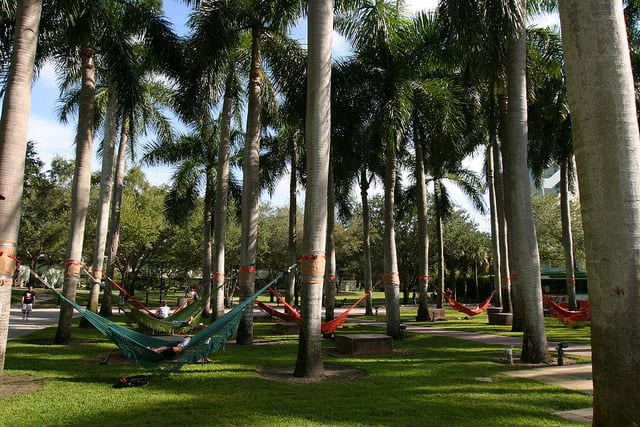Today we welcome to the Mosaic Blog our Mosaic Research Intern, Tripp Harris. Tripp is currently a Learning Sciences PhD student at Indiana University. Tripp shares his take on the affordances of outdoor learning spaces at the University of Miami, and how other schools could innovate to make use of on-campus outdoor space for learning.
The Tropical Campus
“The University of Miami is nestled in the city of Coral Gables, a quiet suburb to the southwest of Downtown Miami, Florida. Lined with royal palm trees, lush foliage, and anchored by the blue serenity of Lake Osceola, UM’s campus (or “The U,” as college football fans call it) is as close to a tropical utopia as it gets among American colleges and universities. The campus’s whitewashed, stucco-clad buildings are a subtle nod to Scarface-era South Beach. UM is truly a crown jewel of South Florida.

As an Americorps member working in Miami-Dade County Public Schools, I spent many weekend mornings on campus at The U. Palm trees and water views aside, the campus there gave me a place to read, catch up on work, and apply to graduate school. The U boasts many outdoor learning spaces, and during my time in Miami, I took full advantage of the setting and its affordances. The campus was a quiet removal from the liveliness of Dade County Schools and the sensory overload that characterizes much of Miami. The academic surroundings helped frame my focus– at least until late morning when dozens of weary undergraduates would emerge from the dormitories to search for breakfast after a night out on the town.

I never attended UM as a student, but I developed a sense of comfort there. As much fun as I had working with high school students throughout the week, getting away from school for a little bit on the weekends in a setting that allowed me to recharge (and enjoy that much needed “introvert time”) was centering. And it was impossible not to be drawn in by the natural beauty surrounding the outdoor study spaces on campus.
It became an integral part of my routine– a smooth bike ride southbound along US 1 through the early morning Miami air, a few hours of quiet time on the coral terrace overlooking Lake Osceola, and a frozen Starbucks beverage to kick off the day. No constant buzz of sirens or car horns, no loud music from competing stereo systems, no bell schedule to spur the movement of classroom chairs on tile school floors every 90 minutes. Just the constant white noise of the fountain, interrupted by the occasional passing water fowl.

Outdoor Spaces
While The U is home to an impressive array of academic buildings–many emblematic of architecture found in greater Miami-Dade–the outdoor spaces are what set the campus apart. Students at Miami have access to many open air study spaces, suitable for collaboration and solo work. Shaded gliders–rocking benches connected to a table under an awning–are placed ubiquitously around campus, providing convenient spots to work between classes (and just enough covering to escape the harsh Miami sun). Students looking for a social study spot can grab a table along one of the high-traffic walkways on campus. Those looking for a more secluded option can find a setup beyond the mangroves on the northwest end of Osceola. For me, I always preferred the tables by the lake, cooled by the shelter of the stunning Shalala Student Center.
UM students are lucky to have regular access to such a range of comfortable outdoor spaces in which to study, collaborate, and learn. Many college students have hectic schedules, and an environment so conducive to spending time outside may help them manage stress and recenter throughout the school week. Spending time on campus surrounded by green space and natural beauty could be especially beneficial for students who live off campus in more urban areas of Miami.

Improved Well-Being
The benefits of outdoor learning environments are well documented in scholarly literature. Some evidence points to possible associations between studying outside and improved memory function. Other findings suggest that working outdoors may have mental health benefits. For students attending college during the era of COVID-19, access to outdoor campus space is as important as ever. Thanks to the South Florida climate, students at UM can take advantage of these spaces year round. While students attending college in other parts of the country may opt for indoor options during the colder months, the balmy late fall temperatures at The U allow students there to continue using outdoor space on campus without interruption.

As a graduate student attending school in a vastly different climate, I miss those warm early mornings in southern Miami-Dade. Bloomington is a beautiful town, especially in the fall. But once December rolls around, I’m heading back inside. What can schools that aren’t blessed with a tropical climate do to maintain some kind of outdoor study space most of the year? Universities have innovated to transform outdoor space to meet public health needs in the time of COVID-19, including IU. Villanova and Notre Dame, for example, will provide access to heated outdoor tents to encourage continued use of open air spaces. Before the winter begins, I hope IU Bloomington continues to develop ways to support usable, comfortable outdoor study options as we approach the brisk late fall and winter months.

So do you feel like studying by the pool? Come on down to The U. Want to read in a hammock under the palm trees? It’s all yours. Meet up with classmates by the lake? Go right ahead. Just don’t get too close to the alligators.”
Do you have similar experiences with outdoor learning spaces? What are your favorite spots on your own campus? How much does the season or weather influence your study-time outdoors? Share your pictures and examples in the comments below!
For more from Tripp, follow him on Twitter: @t_harris0

This work is licensed under a Creative Commons Attribution-NonCommercial-ShareAlike 4.0 International License.

Leave a Reply